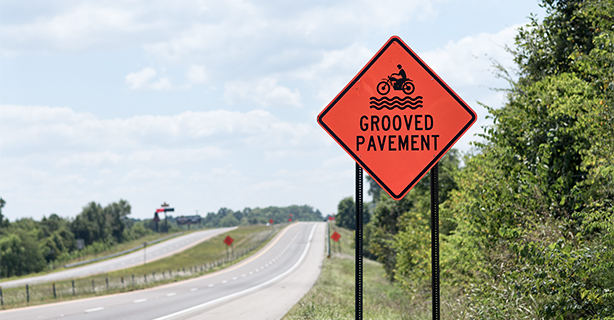Riding your motorcycle safely on grooved pavement
0 min. read
Surface hazards are one of the many hazards motorcycle riders learn to be aware of during a motorcycle safety course. Grooved pavement is one of those hazards, but there are actually several types of pavement grooves that riders will encounter. Let's take a look at the various kinds of grooves, their purpose and some thoughts on dealing with them.
Wet weather traction improvement grooves
This form of pavement groove is installed on road surfaces to help reduce hydroplaning and skidding on wet road surfaces. Often you will encounter these grooved sections on roads that have a history of many wet weather crashes. Although grooved concrete surfaces seem to be more common, this road surface technique also is used on asphalt. Wet weather grooves are applied in two ways: perpendicular to the flow of traffic or parallel. Both function similarly to the rain grooves on your tires — they create channels to remove water from the tire/road contact area. The depth of the rain grooves and spacing between grooves are typically uniform.
The effects of perpendicular rain grooves on your motorcycle's handling are minimal. Think of it being like the rumble strips along the edge of many roads, but smaller. Parallel rain grooves can have a more pronounced effect on handling; it feels like the road surface wants to influence the steering of the motorcycle. “Grooved Pavement” and “slippery when wet” warning signs often precede road sections with parallel grooves. Unfortunately for motorcyclists, parallel rain grooves are less expensive and quicker to install on new road surfaces, which makes them a more widely used option.
Road construction grooves
Highway resurfacing projects create a different type of groove when the old road surface is milled away in preparation for new paving. Road surface milling is almost always done in the direction of travel. Unlike rain grooves, surface milling creates grooves that vary in depth and spacing, often wandering around in the lane. This type of grooved pavement has the most profound impact on motorcycle handling. Worthy of special attention is the frequent presence of particularly deep and wandering grooves in the milled surface. This type of groove is often accompanied by repaired sections of roadbed that are not grooved. The combined effect of the surface irregularities can feel like the road is wrestling with your motorcycle.
Handling grooves
While grooved pavement feels alarming, especially to new riders, it is manageable. Begin by reducing your speed and remaining calm. Apply a firm grip to the handlebars, but don't try to wrestle the front tire. Pay ample attention to the surface. Rain grooved pavement can chip and pothole, and construction milling has those deep wandering grooves. Avoid fixating on grooves, however. By being smooth at the controls you can optimize your traction and safely traverse the grooves.
Till next time, ride safe!
Related links
Road surface hazards come in all shapes and sizes throughout the year. Check out the Safety section of our Resources library for more articles on how to deal with these hazards.
The general information in this blog is for informational or entertainment purposes only. View our blog disclaimer.
*Data accuracy is subject to this article's publication date.







